|
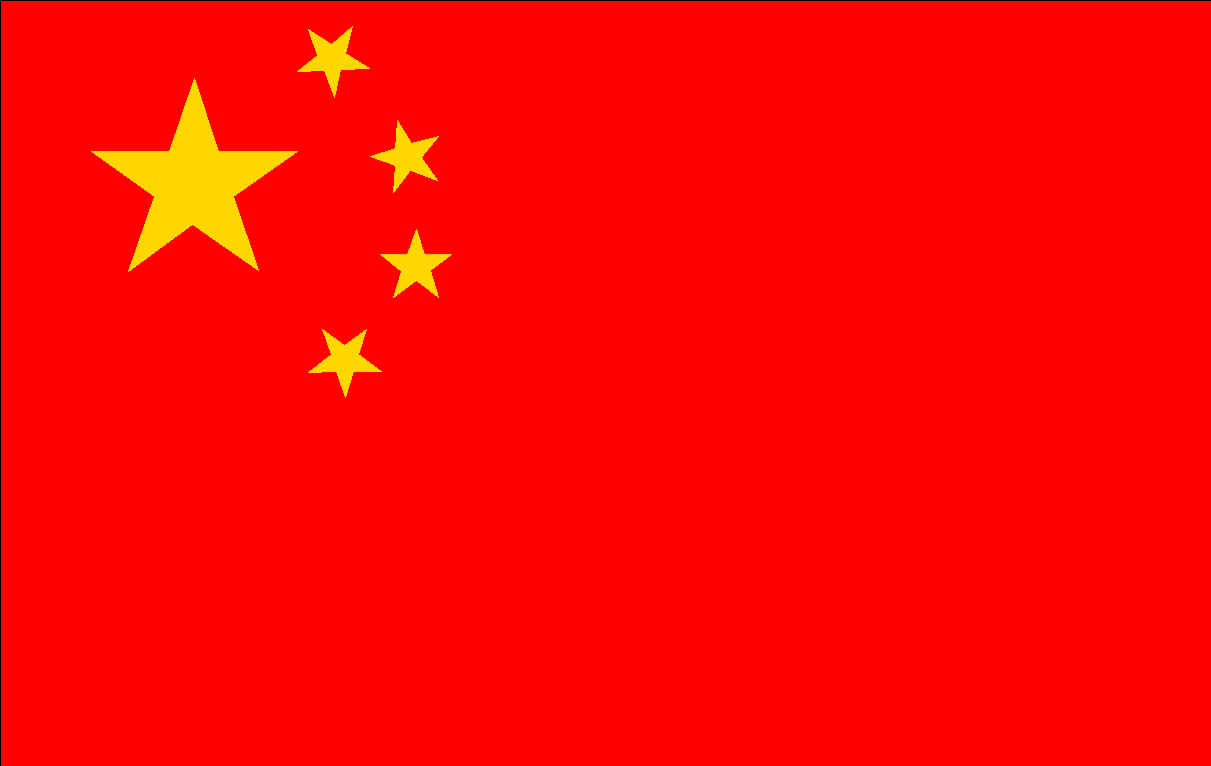
|
Number of versions: 10
Edition: July 1, 2007
|

With thanks to Sukan Man - NL for her translations
of the Chinese.

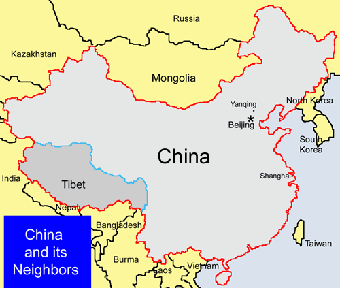
Because China is a country that do not recognizes the Bern Copyright
Convention it simply copies more or less accurately anything they believe there is
business to do with. It is therefore not surprising Chinese businessmen make all
kinds of Monopoly like board games like Real Estate - Millionaire
- Rich Thick Man - Strong Hand - illegal Monopoly and since
2001 also legal Monopoly games from Parker/Hasbro.
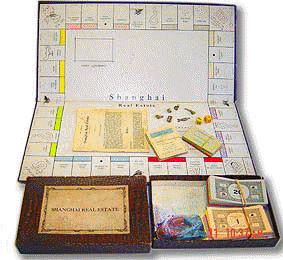 Edition: Shanghai
Real Estate Edition: Shanghai
Real Estate
Publisher: Unknown manufacturer in Shanghai - ± 1937.
Dimensions of the game board: 48.5 x 48.5 cm
The game:
This early Shanghai edition is very interesting, especially
in comparison with the one under here. It consists of a solid game
board and a separate small box for the cards, property deeds, banknotes,
tokens, houses and hotels. The Rules and texts on the board are all in English.
This set is from the collection of Phil Orbanes, who tells about
it:
"The reason the game is printed in English is because the city of Shanghai had a large Western population and was the business center of China. For example, the game of Mah Jongg was westernized and published in English there, during the early
1920s (See Phil's book "The Game makers", page 66 and
next). Thus, soon after word of Monopoly's success reached Shanghai in
1936, some enterprising firm published this game for the Western community
there. China was not a member of the Berne Copyright Convention. Therefore, China was notorious for copying popular works published elsewhere in the world and not paying royalties. That likely accounts for why this game is not called
Monopoly, even though it is a direct unauthorized copy of Parker Brothers 1935 version of the game."
So the design of the Real-Estate-version
is based on the American game board, whereas the Millionaire-version is
clearly based on the Waddington design. However, in order not to resemble
too much the copied design the Chineese manufacturer introduced rather a number
of deviations as there are:
 | Its name is parallel to sides 2 and 4
rather than to 1 and 3. |
 | The Chance and Community Chest spaces are next
to corners Jail and Go-to-Jail. |
 | The jail scoundrel is a poor imitation of the
"real one". |
 | The man directing you to jail doesn't look
much like a policeman. |
 | All corner spaces are uncolored. |
 | The center spaces of the sides are not stations or railways but shipping
lines. |
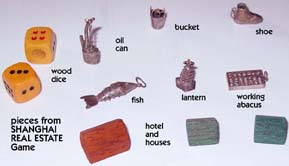 From Go onwards the
properties are: From Go onwards the
properties are:
Yellowish grey: Rubicon Road - Mac Leod Road
Light purple: Columbia Circle - Great Western Road - Avenue
Foch
Red: Route de Say-Zoong - Avenue Petain, Avenue Joffre
Light blue: Honan Road - Canton Road - Hankow Road
Light green: Kiangse Road - Soochow Road - Peking Road
Yellow:
Bubbling Well Road - Yu Yuen Road - West End Gardens
Light pink: Avenue Edward VII - Szechuen Road - Broadadway
Light grey: Nanking Road - The Bund
(The underlined streets are the same as in the Millionaire
edition.)
The 4 shipping lines are: Blue Funnel Line - Dollars S.S.Line - N.D.L
S.S.Co. and China Merchands S.&N. Co.
The Chance and Community
Chest cards have no Uncle Pennybags
illustrations.
The banknotes are printed in black on colored paper and do like
very similar in design to the American banknotes of these days. Inside the circle it reads: "Shanghai Real
Estate 1 ... (or whatever the denomination is) Realty Dollar". The Chinese
character for each denomination is also pictured on each bill, in 2
places.
The 6 tokens suggest to be bracelets charms, see the picture. The
wooden houses are blue green, the hotels
red.
The wooden dice are typical Chinese, showing the large
uncolored one dot.
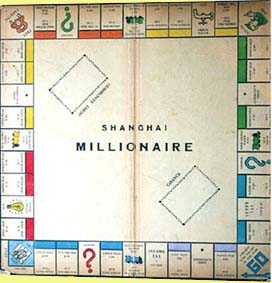 Edition: The Game of Shanghai Millionaire Edition: The Game of Shanghai Millionaire
Publisher: Unknown manufacturer in Shanghai - ± 1940.
Dimensions of the game board: 48.5 x 48.5 cm
The game:
Gary Korzenstein from Toronto - Canada was the owner of the game board
shown alongside. (2002 he granted the board
to the museum
of Yad Vashem - Jerusalem.)
In 2001 Gary told about the story of this board:
"I have been in posession of the game board for the past 25 years. It
was given to my brother in Montreal by a friend of his, who along with his older brother and parents,
fled to Shanghai from
Eastern Europe during or before WW II. They eventually emigrated to Canada
before or during the Chinese Revolution of 1949. Unfortunately I only have
the game board - no money, cards or playing pieces.
I learned from someone else that the game was likely manufactured in Shanghai as
a pirated edition and sold in local stores. The practice was common then,
particularly with books."
Curious to know the background of the presence of Jews in Shanghai I found the
following report on a website of the Jewish Heritage Centre in Winnipeg -
Canada:
"Like the well-known Swedish diplomat Raoul Wallenberg helped escape Jews
from Budapest - Hungary, there were two other diplomats, Chinese Consul General
Dr.Feng Shan Ho working in Vienna - Austria and Japanese Consul Chiune
Sugihara working in Kovno - Lithuania. These men were responsible for
issuing many of the visas that contributed to the effort that eventually allowed
more than 18,000 Jews to flee Europe for Shanghai right before and even
during WW II."
It is obvious that the game is in the English
language while it is likely that most of the emigrants were Germans and
people from Eastern Europe countries. The fact that Shanghai Millionaire is a
copy of the English Waddington's London edition is not so strange because
all European issues of that period were based on that design rather than on the
American Parker Brothers design. The main features of the Waddington design are:
 |
The locomotives on the stations pointing anticlockwise.
Note that on the London game boards all engines are green,
whereas on the above shown Shanghai board one is yellow
and one is blue. |
 |
The Community Chest fields do not show a blue
treasure chest. |
 |
The Super Tax space does not show a gold ring with
diamond. |
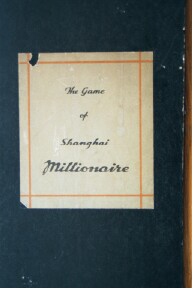 The
game board has a black back with a white sticker on
one section. The
game board has a black back with a white sticker on
one section.
Between 4 red lines is the name
of the game "The Game of Shanghai
Millionaire".
All streetnames are from the city of Shanghai, being from
GO
onwards:
Purple: Avenue Haig - Hart Road
Dark blue: Avenue Road - Yu Ya Ching Road - Peking Road
Red: Honan Road - Tientsin Road - Ningpo Road
Dark yellow: Avenue
Petain - Avenue Roi Albert - Avenue Joffre
Orange: Great Western Road - Yu Yuen Road - Connaught Road
Light yellow: Hardoon
Road - Seymour Road - Bubbling Well Road
Green: Kiukiang Road - Kiangse Road - Szechuen
Road
Light blue: Nanking Road - The Bund
The 4 stations are: East Railway
Station, South Railway
Station, West Railway Station and North Railway Station.
Dec.2004:
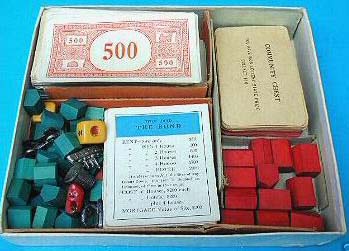 Shanghai
historian Kent McKeever - N.Y. recently bought the box with attributes
belonging to the Shanghai Millionaire game board! And from what the contents
show it is clear the whole edition has been commercially manufactured in
larger quantities than could have been under limited war conditions by emigrants. Shanghai
historian Kent McKeever - N.Y. recently bought the box with attributes
belonging to the Shanghai Millionaire game board! And from what the contents
show it is clear the whole edition has been commercially manufactured in
larger quantities than could have been under limited war conditions by emigrants.
In Kent McKeever's Shanghai site
is to be read:
"From 1844 through 1943 Shanghai was one of the strangest political entities which has ever existed. It was
three geo-political bodies in one, the International Settlement, The French Concession, and the Chinese municipality of Greater Shanghai. During this period, it became one of the leading commercial cities in the world.
While Shanghai did have a section which was a French concession ruled directly from France, another part of the city was called the
"International Settlement" because it was theoretically under the shared control of a number of different countries, including the
Great Britain, The United States, and Japan."
This means there were
important commercial influences from as well the UK (Waddingtons)
as the USA (Parker Brothers). This is also expressed in these
games:
|
Real Estate |
Millionaire |
Parker Bros. design
with single names on the
spaces. |
Waddingtons design with
double names
on the spaces and colored engines driving backwards |
Large board with small
separate box for attributes.
as was common in the early days of Monopoly. |
Large board with small
separate box for attributes.
as was common in the early days of Monopoly. |
| houses
and hotels made of dull wood. |
houses
and hotels made of dull wood. |
The light yellow
Community Chest and orange Chance cards
have rounded edges.
The 6 metal tokens are: old car - boat - canon - thimble - handbag and
iron.
The ivory (?) dice are typical Chinese, showing the large red
one dot.
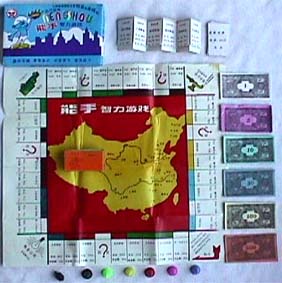 Edition:
NENGSHOU
(capable hand) Edition:
NENGSHOU
(capable hand)
Publisher: Snangyi - ±1970
Dimensions of the small box: 17.0 x 11.0 x 1.9 cm
of the unfolded "game sheet": 38.6 x 35.7 cm
The game:
This is doubtless one of few Monopoly-like games issued in communist China,
because it is not to be expected "comrades" like to play a capitalist
game.
It is unclear why the lid shows a Smurf. Because of the fact that the
Smurfs were "born" in October 1958 and most probably not immediately
were imported in China, I assume this game was issued in about 1970.
The lid of the small box shows under the legible name the name of the
game again with two
red Chinese characters with intelligence
game next to it. The 2 lines on top of the name say: Will you become rich
in the future? So please use ..
Under the silhouette of buildings are 4 entries: imitation market - trade -
intelligence practice and increase skilfulness.
As the small box makes suspecting, and the picture clearly confirms, the design
is very poor. The "game sheet", which isn't worth the name game
board, show 7 groups of 3 and 1 x 4 spaces. They are malls in 25 cities
shown on the map. The two large rivers shown are the Yellow
River (Huang
He) and the Yangtze. From Startpoint onwards the malls are in the
cities:
Green: Harbin - Changchun - Shenyang
Red: Beijing - Tientsin - Shanghai
Blue/black fenced:Taiyuan -
Shijazhlang - Jinan
Red/black fenced: Zhengzhou -
Nanjing - Hangzhou
Green: Huainan - Nanchang - Changsha - Wuhan
Red/black fenced: Quanzhou - Canton
- Haiku
Yellow: Lupanshui - Choingqing - Chengdu
Blue:Xining - Lanzhou - Xi'an
There are no stations, there is however one white space on each side of the
board that build a group with the others. As you can see there is something like
an Electric Company (15 Yuan) and a Waterworks (10 Yuan) but they
are situated at the Jail and Go to Jail spaces. Furthermore are 3 other spaces
the government (!) instead of a bank has to be payed. This are resp.: Central
Pool (40 Yuan) - Transport (35 Yuan), the green
car at the third corner - Tax Authorities (100 Yuan), at the same space as
Westerners must pay tax as well.
Each of 29 Work Permits (30 x 53 mm) instead of the
usual property cards show the name of the corresponding mall of a city, while
the text is printed in the color of the space.
The small cards show 3 amounts, viz.:
-
The amount player has to pay the authoroties to buy the enterprise.
-
The amount another player has to pay the owner. (Double rate in case one
player owns the whole group).
-
The amount the government pay you in case it is sold back. This is always
half the purchase price, which strongly reminds of the mortgage value.
At Startpoint you don't receive salary but can contract a loan at an
interest of 10% instead. As a proof you get a card slightly larger (35
x 61 mm) than the Work Permits are.
There is only one stack of 24 badly printed orange
Chance cards (35 x 65 mm) all showing the same Smurf. They not only
consist of gifts (by the authorities) and penalty payments (to the
authorities), but also of action cards to buy goods.
There are no houses nor hotels with this game. The banknotes are a
bad copy of the Monopoly notes, because except for the denomination in the
centre of the note they also show 4 small rectangulars with resp. a TV-set (?) -
aeroplane - boat and car. The 6 denominations are resp.: 1 (white) - 5
- 10 - 50
- 100 and
500
Yuan.
The 6 tokens are simple pawns of plastic.
There is only one die consisting of an oblong black plastic top
with the numbers 1 to 6.
This set was sold on ebay
for US$ 50.- October 1999.
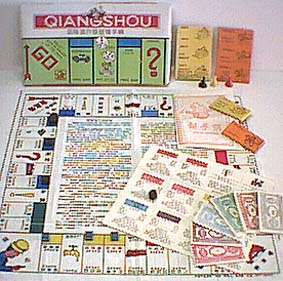 Edition:
QIANGSHOU
(strong
hand), version 1 Edition:
QIANGSHOU
(strong
hand), version 1
Publisher:WTOY WENZHOU - ±2000
Dimensions of the small box: 2.5 x 23.5 x 14.0 cm
of the unfolded "game sheet": 37.0 x 37.5 cm
The game:
This set is property of Michael Hume - UK.
The small lid shows the last part of the 4th side of the
(American) board with GO and 2 dice (on the
Luxury Tax) showing the 3 and 5 as well as a (drawn) racecar on
the Boardwalk field. However, this car is not in this game.
This issue is noticeably no longer communist, because it is clearly a copy of
the Parker Brothers edition of 1985.
The small red logo of the Chinese
manufacturer can be found at the GO field.
Indeed the whole game is of course in Chinese only.
Striking is the "game sheet"; in this case a very soft plastic
cloth that however is well printed. Its midfield is entirely printed with
text (the Rules), because
of which there is no place for the games name, nor for the spaces of both cards.
The boards division is again precisely copied from Parker Brothers. However,
there are a few irregularities, which are probably only caused by careless work,
like:
 |
Space 3 of the game sheet (that should built a group with space 1) has no blue
bar, however there is a property deed with blue
bar for this field. |
 |
The last street of the green group has
a blue
bar on the game sheet, but a green bar
on the property deed. |
The poorly printed property deeds (45 x 55 mm) have to be
detached
from a sheet. All 4 station spaces show the same red
electric train. The prices of the properties are a factor 10 higher than those
of the American and European editions.
The yellow
Opportunity cards (with ?) and orange
Fate cards (with !)
(33 x 60 mm) are poorly printed on brown
cardboard, but they are illustrated with a picture of Rich Uncle Pennybags.
The 6 very poorly printed small banknotes (40 x 70 mm) all have the same design, consisting
of a broad rim with inside at the left a portrait of a politician (?) with on
top oneolardn, at the
right a laurel wreath and a number in the centre oval. The denominations of the one sided color
printed white notes are: 1 - 5
- 10 - 50
- 100 and 500 Yuan.
On the rim of the lid it says the game is for 2 to 4 players but there are only 3
plastic pawns as tokens. So 3 players and the banker?
There are 33 hollow black houses and 12 just as
small hollow blue hotels of plastic.
There is but one die, consisting of an oblong black plastic top
with the numbers 1 to 6.
The Rules are printed in red on one
single sheet and provided with Uncle Pennybags rising from the O.
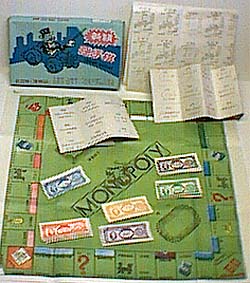 Edition: XINBAN QIANGSHOUQI Edition: XINBAN QIANGSHOUQI
(new publication strong hand game)
Publisher: Inland company - ±2000
Dimensions of the small box: 2.1 x 12.2 x 18.0 cm
of the unfolded "game sheet": 36 x 39 cm
The game:
This set is property of Michael Hume - UK.
This edition matches the Parker Brothers editions much better, except for the
quality:
 |
The uncolored Monopoly-bar-with-Rich-Uncle-Pennybags is
printed in the game sheet's centre in closed black characters. |
 |
The station spaces show the black Parker Brothers engine. |
 |
The cards spaces are situated next to the Go
and Free Parking
(with red car) corners. |
 |
The Fate spaces show
the blue treasure chest. |
 |
The Luxury Tax
space have the gold ring with diamond. |
 |
Passing over Go one receives 200
Yuan. |
All 27 property deeds (40 x 65 mm) are printed on one perforated sheet
of thin paper. And so the
Opportunity cards (with ?) and Fate cards
are printed on untreated perforated cardboard (30 x 43 mm)
The 6 properly printed small banknotes (35 x 68 mm) all have the same design, consisting
of a broad rim with inside at the left a portrait of a politician (?) with on
top the word oneolardn, at the
right a laurel wreath and a number in the centre oval. The denominations of the one sided color
printed white notes are: 10 - 50
- 100 - 500
- 1000 and 5000
Yuan. The value of the devalued banknotes is a factor 10 higher
than those of the previous edition.
I can only assume it to be careless work the set not to have houses and
hotels, nor tokens, dice or Rules, because one cannot
play the game without this items. However, they do sell the game as such!
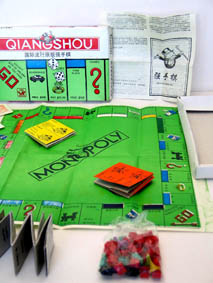 Edition:
QIANGSHOU
(strong
hand), version 2 Edition:
QIANGSHOU
(strong
hand), version 2
Publisher:WTOY WENZHOU - ±2000
Dimensions of the small box: 2.5 x 23.5 x 14.0 cm
of the unfolded "game sheet": 36.0 x 38.5 cm
The game:
This set is property of David Miller - UK.
By comparison of both preceeding editions it is clear this set
is a combination of the box from the first set and the "game sheet"
from the other.
This therefore proves the blue box edition
also to be manufactured by the same manufacturer.
However, there are a few things typical for this version, like:
 |
The only readable words on the Rules of this set say
"Qiang Shouqi",
meaning they come from the blue edition. |
 |
Both the small, hollow houses and hotels have the same
sizes and are made of plastic. They have overhanging roofs.
Given their
number the houses are red and the
hotels blue green. |
 | The irregular sizes of the cards (30/35x58/60 mm) differ from the
other versions. All yellow
ones (presumably the Opportunity? cards) show a running Rich Uncle
Pennybags while all orange
cards (presumably Fate) show our Rich Uncle as a tramp, like in
version 1. |
 | The sizes of the property deeds are 45 x 55 mm,
the same as of version 1, but different from the blue
edition. |
 | The 6 banknotes (45 x 90 mm) are the largest of all
3 versions. The design is still the same, consisting
of a broad rim with inside at the left a portrait of a politician (?) with on
top the word oneolardn, at the
right a laurel wreath and a number in the centre oval. The denominations of the one sided color
printed white notes are: 1 - 5
- 10 - 50
- 100 and 500
Yuan. |
The only 3
tiny plastic tokens are the same as from version 1.
Both dice consist of an oblong black plastic top
with the numbers 1 to 6.
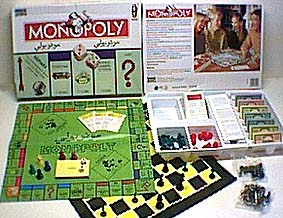 Edition: Falcification of Hasbro Monopoly ref. 14535, in Arabic, Ref.No.2004 Edition: Falcification of Hasbro Monopoly ref. 14535, in Arabic, Ref.No.2004
Publisher: Hongyan - ±2000
Dimensions of the box: 4.8 x 26.6 x 40.5 cm
The game:
This really has never shown before, a falcification without equal!
This in China made edition (partly) in the Arab language in the first
instant suggests to be the officially by Parker Brothers issued French
standard edition of 1996. The ref.number 14535/101 shown
on the bottom of the box stands for a "white box with part of the
4th side with the red Monopoly
bar with Uncle Pennybags" on top, while "101"
is the country number for France. However:
 |
the
most expensive street on the Paris game board is the "Rue de la
Paix", that so needfully had to partly be translated into
English to
"Road Paix". And why is the word Chance (the same in English as in
French) translated into Luck, while on the Go field
the French word Départ
has not been translated and the rest of the text was and in bad English? |
 |
the text next to the "color picture of the laughing family" on
the bottom of the box is again a poor translation into English of the
originally French story. |
 And you will subsequently fall into an other surprise opening the the box,
made of crude brown cardboard, because you
do not get a nice and solid board with the Paris streets but two soft boards1 of them being a chessboard and the other .... a board with the streets of London.
Considering the fact that: And you will subsequently fall into an other surprise opening the the box,
made of crude brown cardboard, because you
do not get a nice and solid board with the Paris streets but two soft boards1 of them being a chessboard and the other .... a board with the streets of London.
Considering the fact that:
 |
the locomotives on the stations are green
and "go back to Go" |
 |
there is no blue
treasure chest on the Community Chest spaces |
 |
nor is there a gold-ring-with-diamond on the Super Tax space |
 |
the centre field of the game board shows Monopoly in open characters |
this game board shows up to be a copy of the English board (according
to the Waddingtons design) . This is
confirmed by the fact that the rent of all yellow
streets is equal (£ 22.-). (This error was only rectified a couple of years
later as the Parker Brothers design with a.o. the black engines
became applied.)
The rectangular Chance cards are yellow,
the Community Chest cards pink. Both
spaces for these cards are provided with a Micky
Mouse figure. This immediately exhort the question if a connection could
exsist between this Chinese manufacturer Hongyan and the makers of corresponding Oman
editions as well those with ref. nr. 7405 from the countries Saudi-Arabia,
Yemen and India?
However, the 7 banknotes have been copied with incredible accuracy and
quality from the original 14535 edition even including the hardly legible text "©1996 Tonka Corporation".
The
7 denominations are resp.: 100 - 500
- 1.000
- 2.000 - 5.000
- 10.000
and 50.000.
The insert of the box is a copy in white plastic of the red
insert of the original edition.
The 6 tokens are simple pawns of plastic. The dark
green houses and red hotels are
of plastic and have overhanging roofs with a chimney.
Of both small dice (with sides of 6 mm) all numbers are in blue pips,
except for the red 4 and the thick red
pip for 1.
Although this set has been "Made in China" it probably was only ment
for export.
The price of this set amounted to S$ 12.90 (€ 6,50) June 2003 in Singapore.
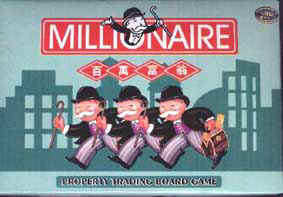 Edition:
Millionaire Edition:
Millionaire
"Property trading board game"
Publisher: Unknown inland manufacturer - ±2000
Dimensions of the box: abt. 15 x 20 cm
The game:
I unfortunately can not tell anything more about this issue except that it was
bought in Shanghai 2002 for the paltry sum of about € 2 .
However, I think it to be better showing the issue exsist rather than not
paying attention to this Millionaire edition suggesting to be an official Parker
issue with those 3 fake Mr. Monopoly men. The bowler hat nor moustache
are those of the real Mr.Monopoly, while the cane is held in the wrong
hand.
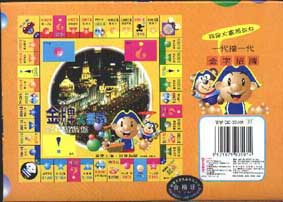 Edition: Thick
Rich Man Edition: Thick
Rich Man
Publisher: Unknown inland manufacturer - ±2000
Dimensions of the box: abt. 15 x 20 cm
The game:
Like with the Millionaire edition I only got the picture shown. It looks like
a Chinese version of the Parker/Hasbro Disney Monopoly.
The picture shown is the bottom side of the box I guess, because it shows the
bar code. The game board shown proofs there are 40 spaces on the board and all
properties are divided in the same
color groups as on the regular Monopoly game board.
This set was bought 2002 in Shanghai for about € 2.
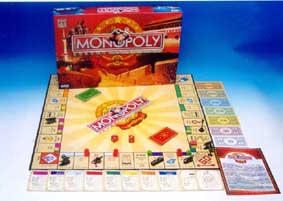 Edition:
China Wall Monopoly, ref. 00010.1390 Edition:
China Wall Monopoly, ref. 00010.1390
Publisher: Parker Brothers/Hasbro
- 2001
Dimensions of the box: 40 x 27 x 5.3 cm
The game:
This very luxury bilingual Hong Kong made edition with its dignified
looking game board makes reminding the 1997 Hong Kong Commemorative
edition.
In this edition you'll get acquainted with 22 large cities in China,
seven of them being described in the Rules booklet.
From Go onwards the properties are:
Huhehaote
- Lanzhou - Northern Train Station -
Urumqi - Jilin
-Harbin
- In Jail - Xian - Power Supply - Kunming
- Guilin - -
Wuhan -
Chongqing
- Chengdu
- Free Parking - Hangzhou
- Hefei - Xiamen
- Southern Train Station - Zhuhai
- Guanzhou -
Water Works - Shenzhen
- Go to Jail - Nanjing - Dalian
- Tianjin - Eastern Train Station -
Beijing - Salary Tax and Shanghai.
The station spaces on the board do not show the usual Parker/Hasbro black engine but a simple drawing of the front of some Chinese train. The
Chance cards are orange, the Community Chest
green.
 The tokens are the 8 bronze tokens like in the Commenmorative Hong
Kong
Edition: a tram - shoe - bath-tub - car - candlestick - cup - elephant The tokens are the 8 bronze tokens like in the Commenmorative Hong
Kong
Edition: a tram - shoe - bath-tub - car - candlestick - cup - elephant
and a running Uncle Pennybags. The
green houses and red hotels are
plastic.
This issue is sold in Hong Kong only.
7 China city stories given in the Rules booklet:
Beijing:
Beijing has been renamed several times in different dynasties in Chinese history. It was firstly named
Xiuzhou in the Tangyu reign 4 thousand years ago. Then it was called Sucheng and for the first time choosen to be the capital of the Yan state some 3 thousand years ago.
As Bejing was the capital city of different dynasties from the 10th century B.C., giving it an imperative historical status in China, it was renamed repeatedly as different dynasties appeared: called as
Yandu in the Liao Empire, Chongdu in the Jin Empire and Dadu in the Yuan Dynasty.
The last 2 dynasties of China, i.e. Ming Dynasty and Qing Dynasty, continued to choose Bejing as
their capital city, lasting for 270 and 260 years in Chinese history respectively.
Eventually Bejing has maintained her superiority as the capital of China till now.
Shanghai:
Located at the central coastline of China, Shanghai was a trading port
developed since the Song Dynasty and became an important city in Chinese history
in the 19th century: after the end of the Opium War in 1842, the Qing
Dynasty was forced to end its policy of isolationisme and opened Shanghai as a
free trading port for Britain and other foreign powers according to the Treaty
of Nanjing. With this special political background, Shanghai was exposed to
western cultural and economic systems, making it a prestigious city with special
culture in the decades. Currently Shanghai is the largest city in China and is
regarded to be the heart of economy in China as well as a modern metropolisl
Nanjing:
With rocky landscape as natural defence for national security, Nanjing was a
hot choice of capital state for several dynasties like Changan and Luoyang.
In today's China, Nanjing is one of the most important cities, having a boosting
development of oil, iron and chemical industry, contributed by the Changjian
River Bridge controlling the main transportation network of China.
Xian:
The rocky landscape of Xian is an excellent national weapon for national
security. That is why Xian was selected to be the capital for several ancient
dynasties before the 11th century B.C.
Xian played an important role in Chinese history of 2000 years ago: since it
became the capital city for the first time during the Western Zhou Dynasty, it
remained being the capital under 11 dynasties, like the Qin Dynasty, Han Dynasty
and the Tang Dynasty.
Xian was named as "Changan" in the Tang Dynasty, being the starting
place of the famous "Sik Road" and an important city for the
international trade.
Guilin:
As the scripture goes, "Guilin scenery wins top ranking compared with
the rest of the world." No other scenery in China is so unique, so indescribably beautiful yet mysterious, nor calls forth such breathless
admiration on the part of visitors as the karst region around Guilin.
Harbin:
Harbin, the capital of Heilongjiang, the northmost province of China, is
located by the Sunghua River. Harbin has an ice-lantern festifal every winter,
which makes it a wonderland of ice.
Huhehaote:
Huhehaote is the self-governing region in China, meaning "Green
City" in Mongolian language. The grave of Wang-chao-jun locates in
Huhehaote.
|